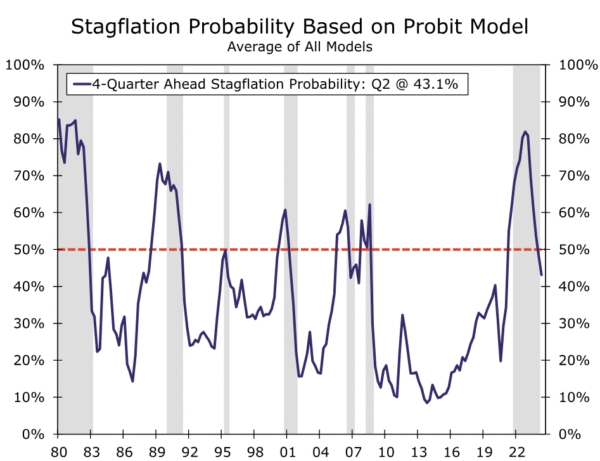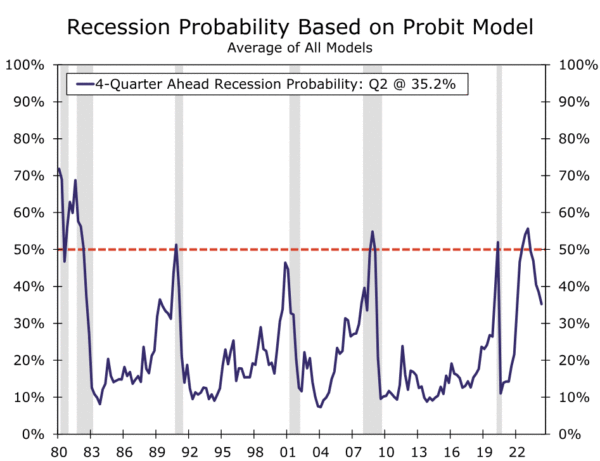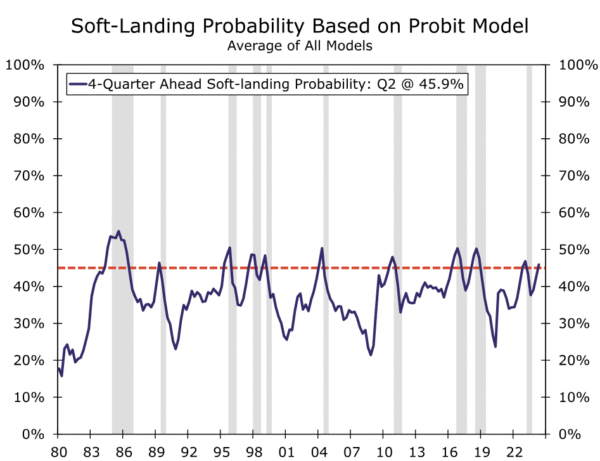Part III: A New Toolkit To Predict Soft-Landings, Stagflation and Recessions
Summary
- In the third installment of this series, we introduce a probit framework to generate four-quarter-out probabilities of three scenarios: recession, stagflation and soft-landing.
- Instead of relying on one regression with one set of predictors, we create several regressions with different sets of predictors to capture information from major sectors of the economy. We therefore have better chances of predicting likely growth scenarios.
- Our probit framework accurately predicted periods of recession, stagflation and soft-landings in the post-1980 era using a threshold of 33%.
- As of Q2–2024, the soft-landing probability is the highest, indicating that the chances of a soft-landing are higher during the next four quarters. However, the persistently higher stagflation and recession probabilities of the past few years may cloud the near-term policy path.
- We believe our framework can help decision makers determine the magnitude and duration of upcoming monetary policy by providing the probabilities of different growth scenarios occurring.
- The next installment of the series will provide a framework to predict monetary policy pivots using the probabilities of the three growth scenarios.
The Probit Framework To Predict Four-Quarter-Out Probabilities of Growth Scenarios
Traditionally, a probit approach is utilized to predict the probability of a near-term recession. We have updated the probit framework to generate probabilities of stagflation and soft-landings in addition to predicting the probability of a recession. The new framework is known as the ordered probit approach.1
We deviate from traditional probit modeling in the sense that instead of relying on one regression with one set of predictors, we create several regressions. Multiple sets of predictors allow greater chances of predicting likely growth scenarios—in comparison to just one set of predictors—by capturing more information from major sectors of the economy. Additionally, as the economy evolves, so do economic risks. For example, higher inflation and interest rates are the current cycle’s major risk to the economy, while the housing boom/bust was linked to the Great Recession. Therefore, in our view, different probit regressions more accurately capture the evolving nature of risks than a single regression. Our probit regressions generate the probability of a soft-landing, stagflation and/or recession occurring in the next four quarters. We created eight different regressions using a unique mix of predictors, as described below. Each regression generates a probability of soft-landing, stagflation and recession as determined by the unique set of predictors. We average all the probabilities to represent the chances of a soft-landing, stagflation and recession as predicted by the major sectors of the economy.
(1) Leading Economic Index (LEI), S&P 500, the ISM-M employment index and CPI
(2) Consumer Price Index (CPI) and the LEI
(3) CPI and Yield Spread (between 10-year and one-year Treasury yields)
(4) CPI and the Chicago Fed National Activity Index (CFNAI)
(5) CFNAI and Yield Spread (between 10-year and one-year Treasury yields)
(6) Yield Spread (between 10-year and one-year Treasury yields)
(7) VIX and the S&P 500
(8) Chicago Fed National Activity Index
The Framework in Action: Do Soft-Landings Hold the Ground?
The simulated real-time, out-of-sample probabilities are plotted in Figure 1.2 The purple bars above the zero-line represent actual periods of stagflation, and the red bars show when GDP growth rates were in soft-landing thresholds (our proposed dates for stagflation and soft-landing episodes). The pink bars below the zero line are attached to recessionary periods as defined by the National Bureau of Economic Research (NBER).
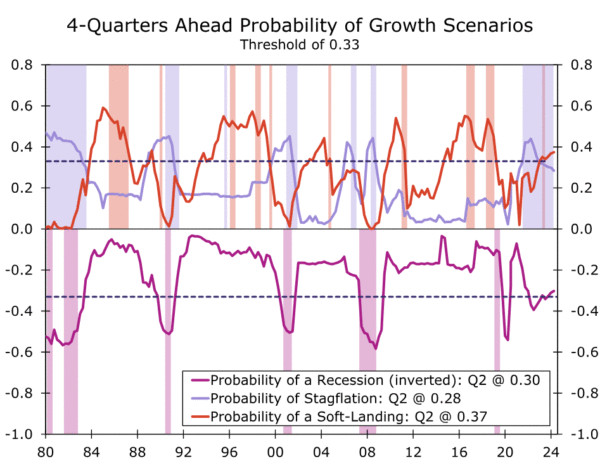
The purple line represents a four-quarter-out probability of stagflation, the red line indicates the probability of soft-landing and the pink line indicates the probability of recession. We converted probabilities of recession into a negative series (probabilities multiplied by minus one), so a probability closer to -1 (minus one) indicates a significant risk of recession within the next four quarters.
A threshold of 33% (0.33) is selected based on the average probabilities of the three scenarios, so if the probability of a scenario is greater than the threshold, then the chances of that scenario occurring during the next four quarters are more likely than not. For example, the soft-landing probability based on Q2–2024 is 37% (0.37), so this indicates that the model suggests a soft-landing is the more likely growth scenario for the next four quarters (Figure 2).
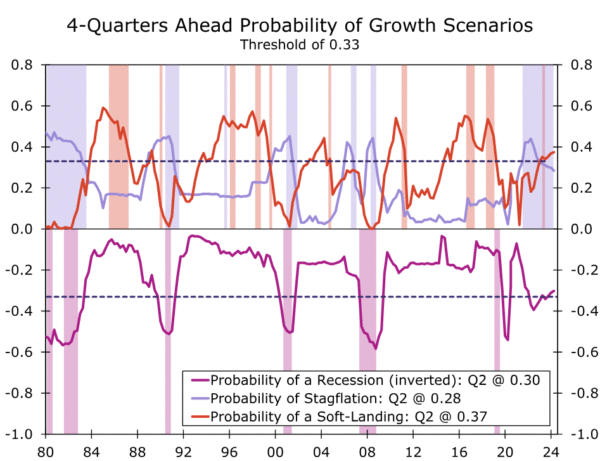
The framework predicts all recessionary periods accurately, as the recession probabilities stay above 33% (or 0.33) during all six recessions in our simulated out-of-sample analysis of the post-1980 era. However, the recession probability crossed the threshold back in Q2–2022, but the NBER never declared a recession in that period (as of Q2–2024). The framework’s recession call is consistent with the private sector’s expectations of a recession during that period. The recession probability based on the most recent data (Q2–2024) is 30% (0.30 in Figure 3).
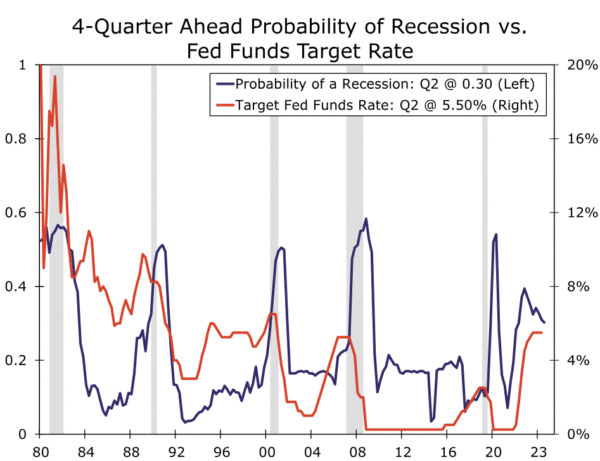
The probit approach accurately predicted periods of stagflation, as the purple line (probability of stagflation) stayed above the threshold during each of the seven episodes of stagflation. In recent years, the stagflation probability line breached the threshold in Q4–2021 and then remained above the threshold until Q4–2022. The Q2–2024 value shows a 28% (0.28) chance of a stagflation episode during the next four quarters (Figure 4).

In sum, the ordered probit framework performed accurately during the post-1980 era. The approach successfully predicted soft-landings, stagflations and recessions using a threshold of 33%. However, the framework inaccurately predicted a recession occurring in recent years, as the economy has yet to fall into a recession as of Q2–2024.
On the other hand, the stagflation probability breached the threshold back in 2021, which turned out to be correct according to our proposed episodes of stagflation. In all, concentrating on more than just the risk of recession would increase the chances to predict potential risks to the near-term economic outlook.
The Three Probabilities To Help Monetary Policy Decisions: An Illustration
To illustrate some key observations from our analysis for the post-pandemic era, we plot the probabilities of the three growth regimes versus the fed funds target rate in Figures 2, 3 and 4. The three separate charts show each growth scenario probability alongside movements in the fed funds rate. All three probabilities breached the threshold in recent years but at three different points in time. The stagflation probability jumped to 42% in Q4–2021, while the recession probability breached the threshold in Q2–2022 (at 37%) and the soft-landing probability hit the threshold line in Q1–2023 (at 33%).
Why are these three probabilities valuable inputs to monetary policy decisions? We believe our framework can help decision makers by predicting the likelihood of different growth scenarios occurring. For example, in March 2022, the FOMC raised the fed funds rate for the first time in the post-pandemic period to combat higher inflation. In total, the Committee raised rates by 525 bps by year-end 2023, the fastest pace of rate hikes in decades. Some analysts suggest that the faster pace of rate hikes was to compensate for the Committee’s misjudgment about inflation, which it initially labeled as “transitory.” In hindsight, our framework would have helped analysts better navigate the 2022 policy pivot. As seen in Figure 4, our framework showed stagflation probabilities trending upward in 2021—a sign that the risk of higher inflation was rapidly developing. To combat that risk, the FOMC may have started to raise rates in 2021 rather than 2022, based on our analysis.
Additionally, the framework’s elevated stagflation probability in 2022 and 2023 would have affected the FOMC’s prediction of four rate cuts in 2024. The stagflation probability has remained at 30% or higher for the 12 consecutive quarters between Q3–2021 and Q2–2024, the longest duration since Q3–1983. This stagflation probability suggests a policy pause may have been needed for a longer duration than the expectations at the time.3
The Elevated Probabilities of Stagflation and Recession Clouds the Near-Term Monetary Policy Path
In summary, the soft-landing probability is the highest, which indicates that the chances of a soft-landing (trend-like growth) are higher during the next four quarters. However, elevated probabilities for all three scenarios would caution analysts to consider more than just two (recession and soft-landing) scenarios.
Taking the last two quarter’s probabilities at face value, both recession and stagflation probabilities trending downward (still elevated, but below the threshold) and the soft-landing probability trending upward (and above the threshold) would suggest a rate cut would be in the picture if the probabilities continue to follow the current trends. However, the persistently higher stagflation and recession probabilities of the last few years may cloud the near-term policy path. Particularly, the pace and magnitude of rate cuts may be different in the current cycle compared to the last business cycle, as the stagflation probability never breached the threshold in the post-Great Recession era. The next installment of the series will provide a framework to predict monetary policy pivots using the probabilities of the three growth scenarios.
Endnotes
1 – Our earlier work has extended the traditional probit approach which forecasts only a binary outcome such as recession and no-recession probability. We have employed an ordered probit framework which allows us to generate simultaneous probabilities of the three scenarios. See wage growth report from July 30, 2021. (Return)
2 – An important note is that we concentrate on the three growth regimes, and thereby, only report probabilities for stagflation, recession and soft-landing. The framework does include options of weak and strong growth periods (as identified by the proposed soft-landing framework, discussed in Part Two). (Return)
3 – It is worth mentioning that the private sector forecasters (using the Blue-Chip consensus as a proxy) were predicting a rate cut by the end of 2023 and four rate cuts throughout 2024. (Return)
Appendix
As a robustness check to our ordered probit framework, we build probit regressions for the three growth scenarios, i.e., three separate sets of probit regressions to generate probabilities of the three growth scenarios. For example, eight different probit regressions are formed to generate a binary outcome for the soft-landing scenario, i.e., predicting the probability of soft-landing and no soft-landing. We repeat the simulation process for recession (recession and no recession) and stagflation (stagflation and no stagflation) scenarios. Moreover, an average of eight probit regressions accurately predicted episodes of soft-landing at a 45% threshold. Average probabilities for recession and stagflation also confirm the accuracy of our proposed ordered probit framework. An important observation from the stagflation probit approach is that the probability hit 80% in Q3–2022, which was the highest probability since Q3–1982. Moreover, the stagflation probability remained above the threshold of 50% for 11 consecutive quarters (from Q2–2021 to Q4–2023) which may cloud the upcoming easing cycle path. The latest stagflation reading (Q2–2024) is 43%, which is below the threshold but still elevated.
